Back in 2020, I wrote a post where I looked at the large number of temples President Nelson was announcing, in contrast with the slow pace at which their construction was taking place. Of course since then, the pace of announcements has only increased. In that post, I mentioned that he had announced 24 across the previous year and a half. Now, he announced 35 new temples in each of the past two years, and slowed only a bit to 15 in Conference a few weeks ago. In this post, I’m going to update the analyses I did for the 2020 post, as well as adding a couple of new ones. Nearly all my data is just taken from the Church’s list of temples, which lists announcement, groundbreaking, and dedication dates.
This first graph shows counts of temples announced, temples having ground broken, and temples dedicated each year since 1950. Note that for 2024, I estimated announcements as two times the number we’ve already had (as we’ve had one of two Conferences), and ground breakings and dedications as three times the number we’ve already had (as we’re about a third of the way through the year).
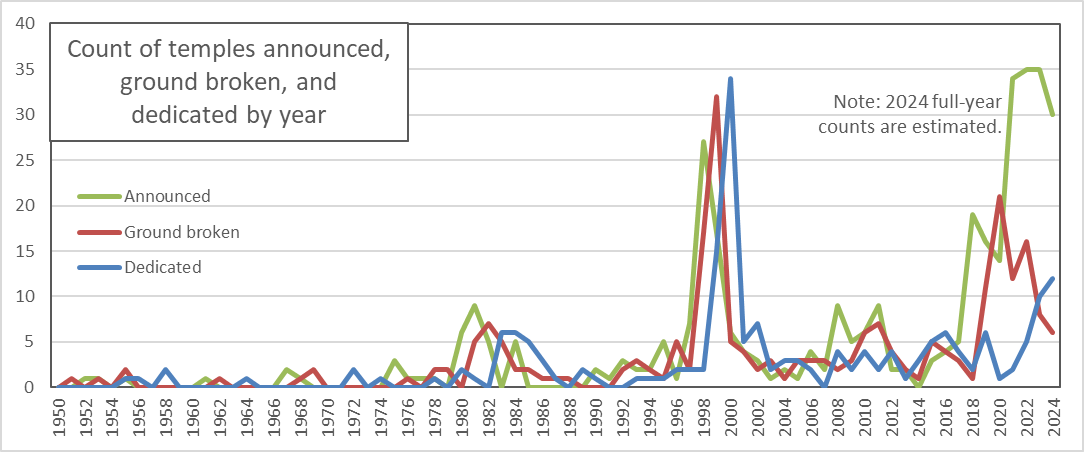
The biggest feature is of course the turn-of-the-millennium rush to get to 100 temples, where a bunch were announced, had ground broken, and were dedicated in pretty short order. The recent increase in announcements hasn’t been followed as reliably by groundbreakings and dedications, although dedications are clearly up since the pandemic. But they aren’t nearly up to the level of announcements.
For the next few graphs, I’ve looked at end-of-quarter snapshots since 1950 (i.e., March 31st, June 30th, September 30th, December 31st) and checked the status of each temple as of that snapshot date. Is it announced, under construction, dedicated, or pre-existent?
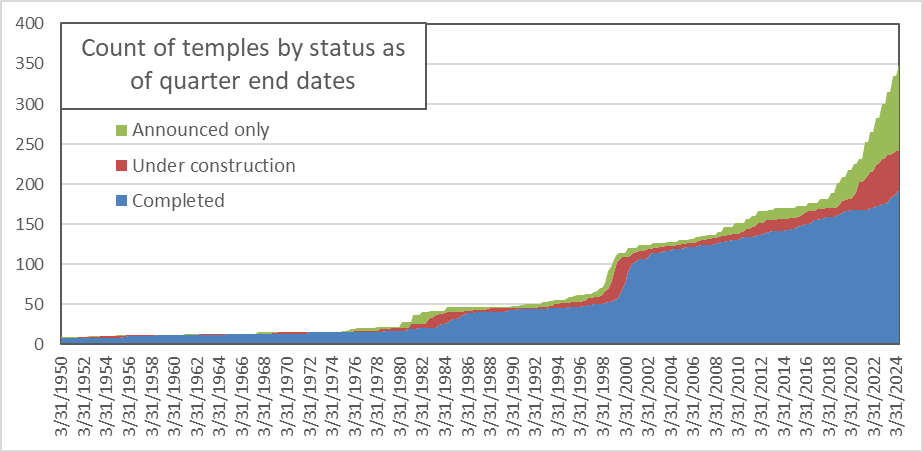
This graph really shows the historically unprecedented pileup of temples that are either announced only or under construction. The Hinckley-era spike, by contrast, had very brief increases in temples announced only or under construction, but these cleared out quickly.
This next graph drops the completed temples from the graph above so it’s easier to focus on the ones that are announced only or under construction.
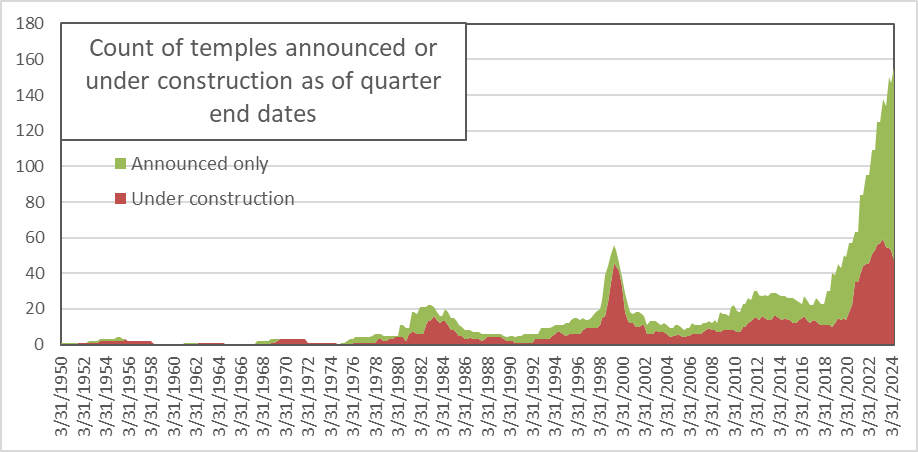
I think this makes the earlier Spencer W. Kimball-era increase in announced temples more clear. But it also shows even more clearly just how many temples are announced but not completed.
This next graph converts the counts in the graph above into percentages of all temples. This is an attempt to adjust for the fact that for a much smaller Church with fewer temples, announcing a couple of dozen new temples was a big deal, where now for President Nelson, with nearly 200 in operation, it’s just a Tuesday afternoon.
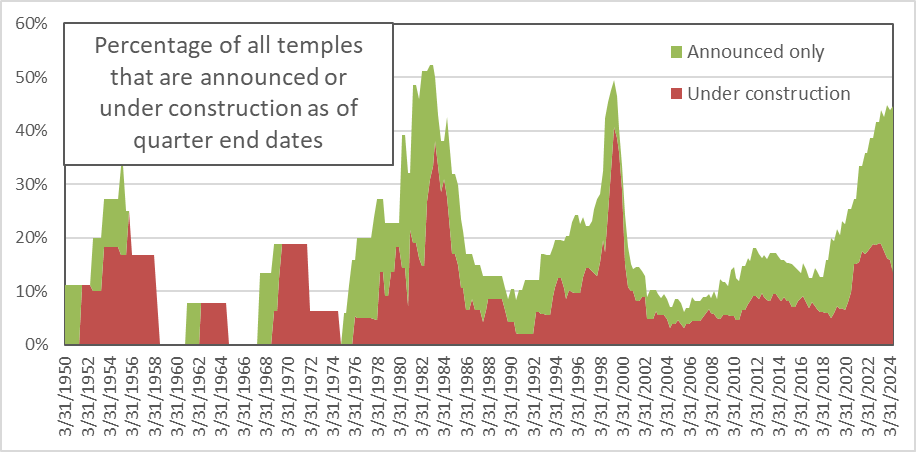
This next graph divides number of members by number of temples. I took year-end membership counts from Wikipedia, and used linear interpolation for the quarter ends in between.
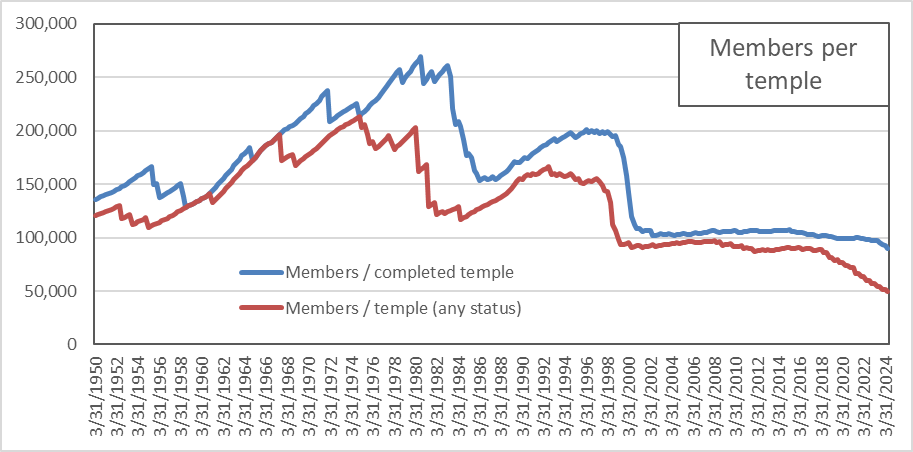
I think this one is really fun! Looking at the upper line, you can see how temple building really lagged membership growth through the 1970s, but then the Kimball-era temple building pushed from over 250,000 members per temple down to 150,000. Then membership growth started to slip away again, before the Hinckley-era boom pushed members per temple all the way down to about 100,000. Since then, members per completed temple hasn’t changed a lot, although it’s been trending down since 2016 or so, and more markedly in about the last year. Looking at the lower line that includes temples announced and under construction, the Nelson-era gap between completed-only and any-status temples looks surprisingly unimpressive. (This is because the gap is a function of the ratio between completed and not completed temples, and the ratio now isn’t that unusual, even if the absolute sizes of the values is much larger.) The level has been pushed down to a historically unprecedented value (at least since 1950) of only 50,000 members per temple.
This next graph shows time to completion for temples completed in a calendar year, since 1980. I dropped 1950-1979 because most years would be blank.
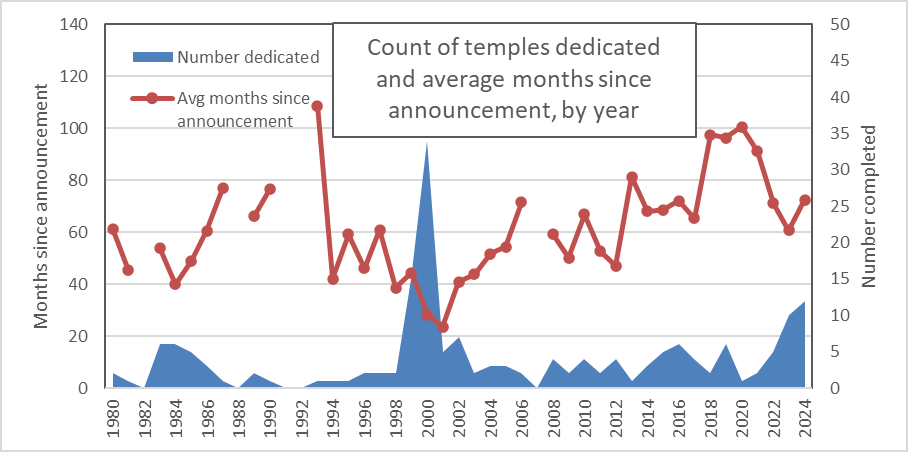
When I made a similar graph for my 2020 post, I thought the time to completion would just go up and up, but it actually went down since 2020. This is just a weakness in the measure, though, as I’m only counting time to completion for temples that are actually completed. All the temples sitting neglected on the drawing board don’t figure in at all.
In this last graph, I show a view of these languishing temples that in overall shape matches the third graph above, but this time breaks the temples down by how much time has passed since their announcement. The graph doesn’t split out temples for which ground has been broken or not.
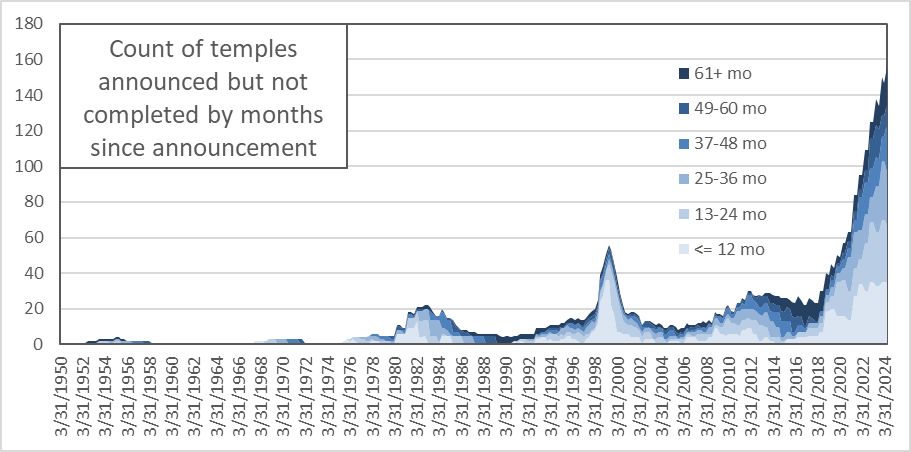
What this graph makes clear is that since the late Monson years (since 2012 or so) has been an unusual time in how many temples have been announced a long time in the past but not yet completed. In the Hinckley-era spike, by contrast, nearly all incomplete temples had been announced no more than a year before. Now we have a lot that are three, four, or even five years out from announcement and still not complete.
I’ve wondered why President Nelson is in such a rush to announce so many temples, particularly when the process of building them isn’t even close to keeping up. Here are explanations I’ve read or come up with:
- He’s trying to control the narrative around the Church’s growth to make it focused on temple building rather than membership counts.
- He’s trying to show for once and for all that he’s the greater prophet than Gordon B. Hinckley.
- He’s seen data that indicates that members who live near a temple are more committed to the Church, so he’s doubling and tripling and n-tupling down on trying to make temples accessible to as many members as possible.
- He’s trying to fulfill the prophecy of temples dotting the earth.
- He knows the Church has vast wealth, and he figures this is as good a use as any for a little bit of it.
- He thinks the Second Coming will be soon, and he wants to get everyone ready.
- He’s like so many bad bosses who tell their underlings to “just make it happen” while demanding the impossible (either implicitly or perhaps explicitly telling the temple department to build 35 temples a year).
- He’s 99 and he figures he doesn’t have much longer to live, so how the project progresses isn’t his problem.
I really like the first three explanations in particular, but I also think the last one shouldn’t be completely ignored.
But the real question is what comes next! I’m so interested to see if President Oaks (or whoever is next in the top seat) steps in and continues to announce dozens of new temples each year, or if he’ll have the guts to say “Read my lips: No new temples!” Or maybe he could steer a middle ground and announce just a few new temples every year. Because President Nelson’s pace isn’t sustainable in at least two senses. First, with each year featuring over 30 new temples announced, and only around 10 completed (10 last year, on pace for 12 this year), he’s been announcing temples that won’t be built for years, if not over a decade. Sure, the pace of construction could be increased, but I wonder realistically how much.
The other sense in which announcing so many temples isn’t sustainable is that temples need temple workers, not to mention patrons! As the members per temple graph above shows, the members per temple of any status has fallen to about 50,000. Sure, the Church will likely add a few more members while the announced temples get built, but if recent experience is any indication, not that many. If it’s net 200,000 new members per year, in line with the past few years, maintaining 50,000 per temple would require four new temples per year, not 30. And think about what that 50,000 number means: if about a third of members on the books are active, that’s 17,000 members per temple. That’s not a lot of people to draw all those temple workers and patrons from, especially considering lots of them are children and teens or caring for children or teens or have jobs or multiple of these, and just don’t have lots of available time. Aiming for a slightly more normal 100,000 members per temple would require only two new temples per year. Could a future Church president stand that?
My best guesses are that future Church presidents will dial the temple announcements way back, that they’ll harangue members for not going to the temple enough when temples are often empty, and that they’ll eventually find that a ton of temples can only be open one or two days a week because of a lack of workers and patrons.
Great analysis. I did some similar analysis after the October general conference and came to similar conclusions (qhspencer.github.io/lds-data-analysis/temples2/). It looks like in the last couple of years we have reached the temple department’s capacity to build new temples. They have clearly grown their capacity but possibly have reached a limit. It seems like if they wanted, the temple department could hire a bunch more people and grow their capacity, but I have to wonder if there aren’t mid-level people who think Nelson won’t be around long and they’ll catch up on the backlog after he’s gone (maybe even the heir apparent!). If true, then we’re probably going to see a pause on announcements.
I think a lot about what could be motivating Nelson and have had similar thoughts. I think there’s been a clear philosophical shift toward bringing temples closer to members who would have had to travel far previously, but I’m not sure that’s enough alone to explain the building spree. I suspect there’s a bit of “if you build it they will come” attitude going on here, that Nelson believes he’s announcing some of the more eyebrow-raising locations as an act of faith that they will get used (after he’s gone of course).
I agree completely that we’re headed for a future of sparse temple schedules and semiannual haranguing about not using them enough.
I agree with the “if you build it they will come” idea. And we have been here before. As related in Prince’s David O. McKay biography, 60+ years ago Henry D. Moyle believed that if you built chapels in abundance people would arrive and fill them up. At the time we had much less money and Prince shows that this approach almost bankrupted the church. We aren’t going to go bankrupt this time, but the idea that building sprees create demand was disproven a long time ago.
I suggest re-reading what Gordon Hinckley said in the October 1997 General Conference when he presented the idea of building many more temples. The aims were explicitly modest: “There are many areas of the Church that are remote, where the membership is small and not likely to grow very much in the near future.” “We will construct small temples in some of these areas.” “They would be presided over, wherever possible, by local men called as temple presidents, just as stake presidents are called. They would have an indefinite period of appointment. They would live in the area, in their own homes. One counselor would serve as temple recorder, the other as temple engineer. All ordinance workers would be local people who would serve in other capacities in their wards and stakes.” “These structures would be open according to need, maybe only one or two days a week.”
A Regina Saskatchewan temple (1998) is not logistically equivalent to a Seattle Washington temple (1975), and not thought to be, so care needs be taken in considering tally counts of temples across decades.
An interesting case is the Anchorage Alaska temple, where Hinckley’s design turned out to be too modest. Originally 6,800 square feet, it was almost doubled in size a few years later. Now construction of a completely new 30,000 square foot structure has begun, replacing the stake center that used to occupy that space. When the new temple building is finished and dedicated, the existing temple will be demolished, and then a new stake center will be built. I have seen a few high schools do that kind of thing: constructing a new building on top of the athletic fields, then demolishing the old building and landscaping new fields over the old building’s footprint.
“He’s trying to control the narrative around the Church’s growth to make it focused on temple building rather than
membership counts.
He’s trying to show for once and for all that he’s the greater prophet than Gordon B. Hinckley.”
Agree. Rusty is a ego maniac. In the last GC they really started pushing that new narrative on growth. It’s only a matter of time when membership growth will be flat and then negative.
The last point about temples only being open a day or two each week has further implications. A temple that’s open five days has some employees who run the laundry and cleaning. Can’t really employ people in that regard 1-2 days a week, which will shift the entirety of the temple operation onto volunteers.
Yes, if you listen to his ’97 talk, President Hinckley said that. He also said constructing a new small temple would cost less than operating a large temple for a year.
I did some calculations after the last conference as well. I’ve seen an estimate that only 7% of the historical world population is on the earth today (8.1 billion today) which means 115.7 billion total have lived. If no more temples are built (announced), that means each temple needs to perform ordinances for over 330 million people. Over 150,000 people die around the world each day, which means more than 450 people needing work per temple each day on top of those 330 million. If each temple were to perform 1,000 ordinances (just endowments) per day (5 days of the week), it would take over 1,200 years. If we have 1,000 temples, it would take 450 years. I’m pretty certain we’ll end up having many more temples announced, probably up to 1,000.
I don’t think building more temples will get those ordinances done any faster if there aren’t enough people to staff them and attend them.
I believe the building of temples throughout the world is a partial fulfillment of Nephi’s prophecy in 1 Nephi chapter 14:
12 And it came to pass that I beheld the church of the Lamb of God, and its numbers were few, because of the wickedness and abominations of the whore who sat upon many waters; nevertheless, I beheld that the church of the Lamb, who were the saints of God, were also upon all the face of the earth; and their dominions upon the face of the earth were small, because of the wickedness of the great whore whom I saw.
13 And it came to pass that I beheld that the great mother of abominations did gather together multitudes upon the face of all the earth, among all the nations of the Gentiles, to fight against the Lamb of God.
14 And it came to pass that I, Nephi, beheld the power of the Lamb of God, that it descended upon the saints of the church of the Lamb, and upon the covenant people of the Lord, who were scattered upon all the face of the earth; and they were armed with righteousness and with the power of God in great glory.
We see today that the church is beginning to look a lot like Nephi’s description of the church of the Lamb of God. It is spreading across the earth–and its dominions are comparatively small. And (IMO) the power of God that will accompany the saints will come from the sanctifying influence of temple work. And so one of the great purposes of building temples in as many of the church’s “dominions” as possible is to strengthen the saints so that they are not overcome by the world.
“He knows the Church has vast wealth, and he figures this is as good a use as any for a little bit of it.”
Except, this doesn’t use up wealth, it increases it. Every time they buy land that appreciates, their wealth increases.
Dave,
Interesting numbers. Unfortunately, those numbers lived over a span of 200,000 years. Are you prepared to teach that in church? And when done with the Homo sapiens, do we have to do Homo neanderthalensis?
@Kim
I know your idea is a common belief, but at some point I’d like to see someone provide some detailed analysis to support that conclusion. How much more is land with a temple actually worth than the price of the land and cost of construction? How much does annual maintenance actually cost? Note that unlike building some kind of commercial structure, the temple isn’t generating revenue. Suppose the church didn’t want a temple any more in a particular location (which is now happening in Alaska). Could they and would they sell it, given its fairly unique layout? Maybe they could as some kind of church, but I don’t think they would get top dollar for it. Few churches have the money to pay for that kind of structure, and the ones that do (megachurches) are looking for a very different type of structure. I also think they might prefer to tear down the temple (which they are doing in Alaska) rather than sell it, given beliefs about the sacredness of the space. I doubt in that scenario the church ends up making a net profit if all the costs are accounted for. So any notion that building temples is creating wealth for the church is, if it exists at all, at best only theoretical paper wealth that is unlikely to ever be realized.
I think 17k active members per temple might be correct, possibly worse in countries with very low activity rates. Then you need to consider how many endowed active temple members there are. I think we will see more changes to rely on technology rather than requiring large amounts of temple workers.
For small temples and sessions, you could get away with one at the front desk, two officiators in the room, a couple at the veil, one in the celestial room, a couple in the baptistery with groups providing their own witnesses, temple presidency, automate lodging names or making it easier to register, a couple doing initiatories. You could probably get away with around 20 workers per day. Possibly less if more changes are made.